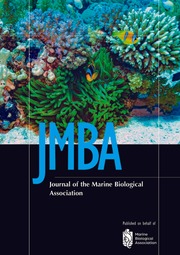No CrossRef data available.
Article contents
Grooved razor clam (Solen marginatus) in the mid-Atlantic Azores: unravelling ecology, phylogeny, and population biology of a new population
Published online by Cambridge University Press: 10 October 2024
Abstract
The first insights on habitat and phylogenetic origin of a newly found population of Solen marginatus are provided in the mid-North Atlantic Azores archipelago, in the bay of Praia da Vitória, Terceira Island. Distribution is confined to the northern portion and most sheltered part of the bay down to 14.2 m depth. Densities with an average of 12.69 individuals/m2 were found at 8.4 m depth, using 4 × 20 sqm visual transects. Sizes of shell length between 10 and 12 cm comprised 60% of collected specimens (n = 118), ranging between 8.79 and 15.4 cm and averaging 11.28 cm. Considering shell length, the high densities and dispersion area, a settlement period above 20 years is estimated. Greater genetic affinity was found in the Ria de Aveiro (North of Portugal) and the Asturias populations (North of Spain). The source origin remains undetermined, with intentional or non-intentional anthropogenic introduction, as well as natural dispersion remaining possible, although more unlikely. Due to the commercial value of this species, a new clam fishery is likely to develop in the area, requiring further studies and immediate conservation measures.
- Type
- Marine Record
- Information
- Copyright
- Copyright © Atlantic Naturalist, 2024. Published by Cambridge University Press on behalf of Marine Biological Association of the United Kingdom


